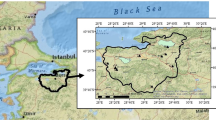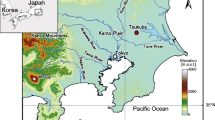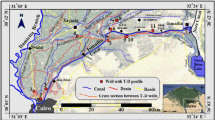Abstract
Electrical conductivity (EC) and temperature logging were carried out in twenty-five borewells/piezometers in a hard rock region of Telangana, India at an interval of 1 and 2 m right from the water table till the bottom of the borewell to study the fracture zones at different depths and to recognize temperature variation with depths. The temperature and EC profiles of the groundwater were recorded at regular intervals along the depths of the borewells, the sensitivity of the sensor of the logger being limited to 0.1 K An attempt was made to calculate the vertical component of the water flux in 25 borewells using the temperature profile measurements in these borewells by applying the heat convection and conduction equation and taking into account the volumetric heat capacity of water and the thermal conductivity of rocks (in the present study, granite). The temperature data was first linearly fitted. The dispersion that would exist in thermal conductivity under the assumption as uniform flux for 22 of the borewell’s is unlikely, and data was fitted to the exponential trend of the temperature profile, considered to a non-zero water flux. This approach resulted in a comparatively better fit than the linear variation. Thus the water flux was calculated for 22 sites using the exponential variation relationship. It was found that the water flux ranges from 4 to 30 mm/year, which shows significant large variation from one location to other. It was also observed using the temperature measurements at the surface (from the temperature recorded at the meteorological station) that the temperature at depths is not affected by the variations at the surface, which confirms the reliability of vertical velocity/flow rate determination.
Similar content being viewed by others
References
Basic Data Report; BDR from AP Groundwater Department (2001) (Basic Data Report of Piezometer Drilled Under Indo-French Project, Maheshwaram, Office of the Deputy Director, Groundwater Department, Ranga Reddy District, Hyderabad, 2001).
Bredehoeft, J.D., Papadopulos, I.S. (1965) Rates of vertical groundwater movement estimated from the Earth’s thermal profile. Water Resour. Res., v.1, pp.325–29.
Cosenza, P., Guérin, R. and Tabbagh, A. (2003) Relationship between thermal conductivity and water content of soils using numerical modelling. European Jour. Soil Sci., v.54, pp.581–587.
Cheviron, B., Guérin, R., Tabbagh, A., and Bendjoudi, H. (2005) Determining long-term effective groundwater recharge by analyzing vertical soil temperature profiles at meteorological stations. Water Resour. Res., v.41, W09501, doi:https://doi.org/10.1029/2005WR004174.
Davis, S.N. (1999) Humboldt, Arago, and the temperature of groundwater. Hydrogeol. Jour., v.7, pp.501–3.
de Vries D.A. (1963) Thermal properties of soils. In: W.R. van Wijk (Ed.), Physics of Plant Environment. North-Holland, Amsterdam, pp.210–235.
Gupta, M.L., Sharma, S.R. and Sundar, A. (1991) Head-flow and heat generation in the Archaean Dharwar cratons and implications for the southern Indian shield geotherm and lithospheric thickness. Tectonophysics, v.194, pp.107–122.
Harinarayana, T., Abdul Azeez, K.K., Murthy, D.N., Veeraswamy, K, Eknath Rao, S.P., Manoj, C., Naganjaneyulu, K. (2006) Exploration of geothermal structure in Puga geothermal field, Ladakh Himalayas, India by magnetotelluric studies. Jour. Appl. Geophys., v.58, pp.280–295.
Hashimi, S.A.R., Engerrand, C. (1999) Groundwater status report for Maheshwaram Watershed, A.P., India, Technical Report of APGWD.
Hillel, D. (1971) Soil and Water: Physical Principles and Processes, Academic, New York.
Hochstein, M.P. and Yang Zhongke (1992) Modelling of Terrain-Induced Advective Flow in Tibet: Implications for Assessment of Crustal Heat Flow. Proc. 7th Workshop on Geothermal Reservoir Engineering Stanford University, StanFord, California, January 29–31, 1992 SGP-m-141, pp.153–157. http://adsabs.harvard.edu/abs/2006AGUFM.T51B1525R (Southern India_Heat flow.htm).
Kumar, D. (2004) Conceptualization and Optimal Data Requirement in Simulating Flow in Weathered-Fractured Aquifers for Groundwater Management. Ph.D. thesis, Osmania University, Hyderabad, Andhra Pradesh, India, 213p.
Kumar, D., Ahmed, S., Krishnamurthy, N.S., and Dewandel, B., (2007) Reducing ambiguities in vertical electrical sounding interpretations: A geostatistical application, Jour. Appl. Geophys., v.62(1), pp.16–32, doi:https://doi.org/10.1016/j.jappgeo.2006.07.001
Maréchal, J.C., Dewandel, B., Subrahmanyam, K. (2004) Use of hydraulic tests at different scales to characterize fracture network properties in the weathered-fractured layer of a hard rock aquifer. Water Resour. Res., v.40 (W11508), pp.1–17.
Pandey, O.P., Agrawal, P.K. (1999) Lithospheric Mantle Deformation beneath the Indian Cratons. Jour Geol., v.107, pp.683–692.
Rangarajan, R., Prasada Rao, N.T.V. (2001) Natural recharge measurements in Maheshwaram granitic watershed, Ranga Reddy District, Andhra Pradesh, India: 1999 Monsoon. Technical Report no. NGRI-2001-GW-298: 14p.
Roy, S. and Srinivasan, R. (2006) http://adsabs.harvard.edu/abs/2006AGUFM.T51B1525R
Roy, S. and Rao, R.U.M. (2000) Heat-flow in the Indian shield. Jour. Geophys. Res., v.105, pp.25587–25604.
Rao, R.U.M., Roy, S. and Srinivasan, R. (2003) Heat-flow researches in India: results and perspectives, In: Mahadevan, T.M., Arora, B.R. and Gupta, K.R., (Eds.), Indian Continental Lithosphere, Emerging Research Trends: Mem. Geol. Soc. India, v.53, pp.347–391.
Ray, L., Kumar, P.S., Reddy, G.K., Roy, S., Rao, G.V., Srinivasan, R., Rao, R.U.M. (2003) High mantle heat-flow in Precambrian granulite province: evidence from southern India. Jour. Geophys. Res., v.108, 2084, doi: https://doi.org/10.1029/2001JB000688.
Roy, S., Ray, L., Bhattacharya, A., and Srinivasan, R. (2008) Heat-flow and crustal thermal structure in the Late Archaean Closepet Granite batholith, south India: Internat. Jour. Earth Sci. (Geol Rundsch), v.97, pp.245–256. doi:https://doi.org/10.1007/s00531-007-0239-2.
Ray, L., Roy, S. and Srinivasan, R. (2008) High radiogenic heat production in the Kerala Khondalite Block, Southern Granulite Province, India: Internat. Jour. Earth Sci. (Geol. Rundsch), v.97, pp.257–267. doi:https://doi.org/10.1007/s00531-007-0278-8.
Roy, S., Ray, L., Kumar, P.S., Reddy, G.K., and Srinivasan, R., (2003) Heat-flow and heat production in the Precambrian gneiss-granulite province of southern India, In: Ramakrishnan, M. (Ed.), Tectonics of Southern Granulite Terrain. Mem. Geol. Soc. India, v.50, pp.177–191.
Roy, S., Ray, L., Bhattacharya, A. and Srinivasan, R. (2007) New heat-flow data from deep boreholes in the greenstone-granite-gneiss and gneiss-granulite provinces of south India: DCS-DST Newsletter, v.17(1), p.8–11.
Smith, L., Chapman, D.S. (1983) On the thermal effects of groundwater flow. 1. Regional scale systems. Jour. Geophys. Res., v.88, pp.593–608
Stallman, R.W. (1963) Methods of collecting and interpreting ground-water data, USGS Water Supply Paper 1544-H, pp.36–46.
Suzuki S. 1960. Percolation measurements based on heat flow through soil with special reference to paddy fields. Jour. Geophys. Res., v.65, pp.2883–2885.
Tabbagh, A., Bendjoudi, H., Benderitter, Y. (1999) Determination of recharge in unsaturated soils using temperature monitoring. Water Resour. Res., v.35(8), pp.2439–2446.
Woodbury, A.D., Smith, L. (1998) Simultaneous inversion of hydrogeologic and thermal data. 2. Incorporation of thermal data. Water Resour. Res., v.24, pp.356–72.
Acknowledgements
Author is thankful to Dr. V.M. Tiwari Director, CSIR-National Geophysical Research Institute, Hyderabad, India, for his kind permission for publishing the scientific work and important results on groundwater studies. Author is very much thankful to Prof. Alain Tabbagh for discussion on the temperate data set in hard rock region as well as consistent guidance for this work. Author is also thankful to the IFCPAR, New Delhi for partially sponsoring the scientific project work on groundwater studies, which was completed successfully. The CSIR-NGRI reference number of the manuscript is NGRI/LIB/2020/Pub-178. The necessary comments and suggestions by the anonymous reviewer, significantly improved the presentation.
Author information
Authors and Affiliations
Corresponding author
Rights and permissions
About this article
Cite this article
Kumar, D. Estimating Water Flux in a Granitic Aquifer from Temperate Profile Measurements in Borewells of a Hard Rock Region, India. J Geol Soc India 97, 900–906 (2021). https://doi.org/10.1007/s12594-021-1789-9
Received:
Accepted:
Published:
Issue Date:
DOI: https://doi.org/10.1007/s12594-021-1789-9




